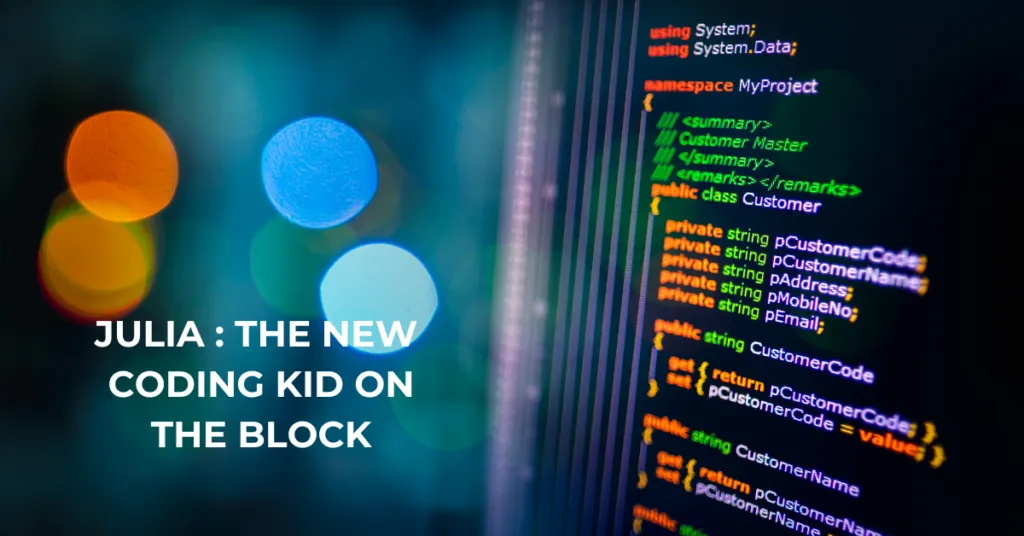Why the Julia Programming Language is Reshaping the AI Paradigm

- What is the Julia Programming Language and Why is it Gaining Traction in the AI Community?
- How Does Julia Compare to Other Programming Languages Commonly Used in AI?
- Are There Any Notable Use Cases or Success Stories of Julia in the AI Industry?
- What Resources are Available for AI Professionals Looking to Learn and Work With Julia?
Within the programming fraternity, the Julia programming language stands out as a revolutionary force in numerical computing and AI development. Gaining significant attention, Julia entered the top 20 of the Tiobe index in August 2023, showcasing its growing popularity with a 0.85% rating. This blog looks at the increasing interest in Julia, diving into its unique features, advantages, and impactful applications across various industries.
What is the Julia Programming Language and Why is it Gaining Traction in the AI Community?
1. The Emergence of Julia in AI
Julia is swiftly establishing itself as a dominant force among trending languages in AI. It masterfully balances the ease of syntax with the power of high-performance computing. Furthermore, its intuitive syntax and unparalleled flexibility position Julia as an essential asset for AI professionals.
2. Julia’s Unique Capabilities in AI Development
In the competitive field of AI development, the Julia programming language distinguishes itself by efficiently managing complex numerical computations. This capability not only solidifies its status as a formidable contender but also underscores the critical role of Julia programming in AI development. Moreover, the benefits of Julia for AI are extensive, including rapid computation speeds and seamless compatibility with other programming languages. Consequently, these attributes are drawing a growing number of developers to explore the potential of this adaptable language.
3. Transformative Impact on Machine Learning
Julia’s involvement in machine learning projects highlights its adaptability and robustness. Furthermore, the Julia language acts as a beacon for innovators in AI and machine learning because it offers a unique combination of speed, efficiency, and simplicity unmatched in the programming landscape. As a result, as Julia in machine learning continues to evolve and gain recognition, it promises to expand the horizons of AI development, pushing the boundaries of what is achievable in these fields.
ALSO READ: How Can a Coding Program Help You Switch Your Career?
How Does Julia Compare to Other Programming Languages Commonly Used in AI?
1. Julia vs. Python: The Speed Advantage
Python, long revered for its simplicity and versatility, has been the go-to language for countless AI professionals. However, Julia language emerges superior in execution speed, a critical factor in AI applications where processing efficiency can significantly impact outcomes. This speed advantage makes Julia an increasingly preferred choice for those working on performance-critical AI projects. Moreover, Julia’s ability to compile high-performance machine code in real-time ensures that AI developers can achieve faster results without sacrificing the quality or complexity of their work.
2. Julia and R: A Synergy for Data Scientists
For data scientists, the transition from R to Julia represents a leap toward more cohesive and efficient numerical analysis. While R has been a staple for statistical computing, Julia offers a more integrated environment for handling complex data without compromising the ease of use that R users have come to appreciate. This synergy between Julia and R enhances the toolkit available to data scientists, enabling them to tackle more sophisticated analyses with greater ease and efficiency.
3. Julia vs. MATLAB: Breaking the Barriers
Julia directly challenges the constraints imposed by proprietary software like MATLAB, offering a compelling open-source alternative that does not skimp on computational power. This breakthrough is particularly significant for researchers and developers who require robust numerical computing capabilities but are hindered by the high costs or restrictive licenses of MATLAB. Julia’s open-source nature not only democratizes access to high-level computing but also fosters a collaborative environment where users can share, modify, and improve upon existing code, driving innovation in AI development.
4. Bridging the Gap With C and Fortran
In scenarios demanding intense computational efforts, Julia stands out by providing an experience that rivals, and in some cases surpasses, that of C and Fortran. Thanks to its Just-in-Time (JIT) compilation, Julia for AI professionals can execute complex numerical tasks with remarkable efficiency. This, as a result, bridges the gap between high-level ease of use and low-level computational prowess. This capability is especially valuable in AI development, where the processing of large data sets and execution of complex algorithms are commonplace.
ALSO READ: Why All Aspiring Coders Should Learn How to Use Swift
 What are the Advantages of Using Julia in AI Development?
What are the Advantages of Using Julia in AI Development?
1. Speed That Sets the Standard
The Julia programming language redefines expectations with its execution speed, a paramount advantage in AI development. This rapid processing capability facilitates the efficient handling of complex algorithms, making Julia a frontrunner among the trending languages in AI. Moreover, this speed ensures that AI models can be trained and deployed faster, significantly accelerating the development cycle.
2. Unmatched Ease of Use
Julia is renowned for its syntactical simplicity, appealing to both newcomers and experienced programmers. This accessibility is particularly beneficial for Julia for AI professionals, especially those transitioning from other languages. Moreover, Julia’s intuitive design simplifies the coding process, enabling developers to concentrate more on innovation and less on overcoming language complexities.
3. Versatility Across AI Domains
The versatility of the Julia programming in AI development is evident in its wide application across various AI domains, from machine learning to deep learning and beyond. This adaptability makes Julia an invaluable tool in the arsenal of AI developers, enabling them to tackle a broad spectrum of projects with a single, powerful language. Furthermore, when it comes to the question of compatibility, the benefits of Julia for AI are indisputable because it is extremely compatible with other programming languages and tools.
4. Rapid Prototyping to Production
The Julia programming language excels in swiftly transforming ideas into working models, a critical feature for Julia programming in AI development. Its support for rapid prototyping allows teams to iterate quickly and refine AI models with efficiency. This capability not only speeds up the research phase but also smooths the transition to production, ensuring that innovative solutions can be deployed with minimal delay.
ALSO READ: How to Learn Programming and Transition Your Career in Technology
Are There Any Notable Use Cases or Success Stories of Julia in the AI Industry?
1. Mastering Numerical Computing
Julia excels in numerical computing, offering packages such as LinerAlgebra.jl for linear algebra tasks. Additionally, NonlinearSolve aids in root-finding, while ForwardDiff and Enzyme enable automatic differentiation.
2. Advancing Machine Learning
Designed specifically for machine learning, the Julia programming language significantly enhances training times and lowers deployment expenses. The Machine Learning in Julia (MLJ) framework underpins its extensive capabilities in this domain. Furthermore, Julia excels in various machine learning tasks, from supervised learning models like regression and classification to unsupervised learning tasks such as clustering and dimensionality reduction. Additionally, its ability to handle large data sets with ease and integrate with existing data science tools makes Julia a powerful ally in developing sophisticated AI systems.
3. Streamlining Statistics
Julia stands out as a formidable statistics tool, bolstered by the StatsKit meta-package. This package equips users with an array of statistical analysis tools, including regression analysis, hypothesis testing, and time-series analysis. Moreover, Julia facilitates seamless data manipulation and visualization, enhancing the efficiency of statistical workflows.
4. Diversifying General Programming
Julia’s flexibility shines in general programming, allowing for the development of diverse software solutions. For example, the Blink.jl enables developers to create sophisticated Electron GUI applications with minimal effort. Similarly, Miletus extends Julia’s functionality to the financial sector, simplifying the creation and management of complex financial contracts.
5. Innovating Web Development
Julia offers robust web development tools such as Genie.jl and Dash.jl. Genie is a full-stack framework, while Dash.jl connects to the Dash ecosystem.
6. Revolutionizing Industries
The Julia programming language impacts various sectors, from pharmaceutical modeling with Pfizer and AstraZeneca to parallel supercomputing in astronomy. In finance, JuliaFin aids in financial modeling. Robotics and network security also benefit from Julia’s efficiency.
ALSO READ: How a Coding Class Can Boost Your Career in 2024: 5 Benefits
What Resources are Available for AI Professionals Looking to Learn and Work With Julia?
For AI professionals keen on mastering Julia, there are a wealth of resources. Firstly, courses like Introduction to Julia (for Programmers) and Julia for Data Science by the Julia Academy lay the groundwork. Moreover, YouTube channels feature Julia Tutorials for visual learners.
Additionally, books like Julia for Beginners by Erik Engheim and Julia for Machine Learning by Zacharias Voulgaris delve into more advanced topics. Another book to learn about Julia is Beginning Julia Programming for Engineers and Scientists by Sandeep Nagar. This one particularly caters to those in technical fields. There are many more courses and written texts available online. Together, these resources equip learners with comprehensive Julia knowledge, from basics to advanced applications.
Reflecting on the Julia programming language journey, its importance in the tech world shines brightly. At the beginning of 2022, which was the 10-year milestone of the programming language, Julia Computing shared a milestone: it saw more than 35 million downloads. This impressive figure not only underscores Julia’s rising fame but also its key role in AI and the future of machine learning. As Julia keeps advancing, its influence in the AI realm is set to increase. This makes it a crucial skill for industry professionals. Eager to deepen your machine-learning knowledge with advanced platforms like Julia? Consider joining Emeritus’ online coding courses for an immersive learning experience and to enhance your career prospects.
Write to us at content@emeritus.org






